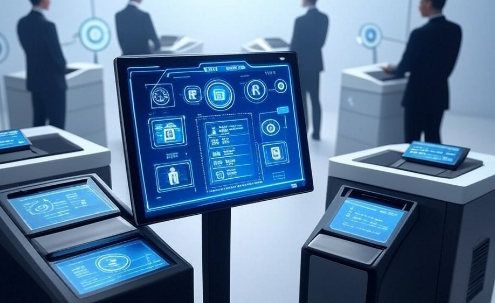AI Agents and Their Role in Enhancing Enterprise Security

AI adoption in enterprises is accelerating faster than governance can keep pace. Healthcare, insurance, fintech, and legal organizations are embedding AI into workflows that once relied entirely on human judgment. These systems now run claims, validate contracts, assess patient eligibility, and process policy updates in seconds.
But with this transformation comes a new reality, automation alone isn’t enough. Security, compliance, and trust must evolve in step.
That’s where AI agents for enterprises enter the picture. These next-generation “AI employees” bring reasoning, context awareness, and autonomy, but they also introduce new opportunities to strengthen enterprise security, not weaken it.
The Rise of AI Agents in Enterprises
AI agents act as universal digital employees, intelligent systems that work across departments, understand context, and make decisions within set parameters.
Unlike static bots, they operate within generative workflow engines, coordinating tasks, data access, and communications securely. This orchestration layer is what separates modern enterprises from those still running basic process automation.
As these systems scale, the challenge grows: each agent handles sensitive data, user credentials, and private systems. Security cannot be an afterthought; it must evolve alongside AI integration, becoming embedded in the agent architecture itself.
What Sets Modern AI Agents Apart
Modern AI agents are not “one-size-fits-all chatbots.” They’re adaptive entities designed to work in complex enterprise ecosystems.
- Fusion of private and public models: Agents can operate on hybrid AI stacks, combining public LLM reasoning with private domain data for accuracy and security.
- Conversational automation with adaptability: They communicate naturally, retain context, and make decisions across multi-turn dialogues.
- Full lifecycle deployment: From candidate screening in HR to claims processing in insurance and compliance auditing in finance, agents function as digital coworkers with accountability.
This evolution introduces a new security paradigm, where every autonomous process is both productive and protected.
Impacts on Organizational Processes
AI agents are reshaping how sensitive data and internal processes are managed:
- Streamlined data workflows: Agents can securely access, redact, and route confidential information without human exposure.
- Instant scalability: Enterprises can deploy hundreds of agents instantly, scaling output without increasing insider threat risk.
- Real-time oversight: Centralized dashboards monitor agent behavior and enforce compliance policies continuously.
For organizations managing regulated workloads, these capabilities redefine both efficiency and defense.
Core Security Challenges for Enterprises
While the benefits are clear, enterprise leaders face new layers of risk as they adopt autonomous AI systems:
- Rising attack complexity — Threat actors now use generative AI for phishing, data poisoning, and impersonation.
- Insider risks — Employees or misconfigured agents may unknowingly expose sensitive data.
- Public model exposure — Using unvetted public APIs for sensitive workflows can lead to the leakage of confidential information.
- Regulatory pressure — Healthcare (HIPAA), finance (GLBA), and insurance (NAIC) all require strict data governance and explainability.
AI introduces both new opportunities and new vulnerabilities, demanding a rethink of enterprise defences.
How Traditional Automation Falls Short
Legacy automation, static scripts and RPA bots, was never designed for the dynamic threat surface of AI-era enterprises.
- Rigid scripting means no response to real-time anomalies or emerging risks.
- Exposed endpoints increase vulnerability when workflows touch sensitive data.
- Lack of situational awareness prevents the system from detecting misuse or policy violations.
In short, traditional automation executes; it doesn’t think. And in a world where threats evolve hourly, enterprises need systems that detect, adapt, and defend autonomously.
Compliance and Data Governance Gaps
Many enterprises discover compliance weaknesses as soon as AI scaling begins. Common failures include:
- Data exposure in shared or external model environments.
- Redaction oversights, where personally identifiable information (PII) slips through preprocessing.
- Inconsistent policy enforcement across departments using different AI vendors.
A compliance lapse isn’t just a technical flaw — it’s a reputational and financial risk. A single unredacted dataset can trigger audits, fines, and customer distrust.
How AI Agents Enhance Enterprise Security
AI agents now play an active role in strengthening enterprise defences. Built correctly, they serve as both productivity amplifiers and autonomous guardians.
- Dynamic threat detection: Agents monitor network and system logs, spotting anomalies before escalation.
- Proactive mitigation: They can pause suspicious activity, flag compromised credentials, or quarantine affected files automatically.
- Intelligent redaction: Sensitive fields are stripped from data before reaching large language models, ensuring privacy at the model input layer.
- Private model customization: Enterprises can host LLMs on secure servers or in private clouds, ensuring control over training data and inference traffic.
According to IBM’s 2025 Cost of a Data Breach Report, companies using AI-based security automation reduced breach costs by over $1.9 million on average — a clear indicator of value when AI is implemented responsibly.
Network and Application Protection
AI agents can now act as human firewalls, detecting unusual activity, verifying access patterns, and enforcing zero-trust rules.
- They continuously analyze who is accessing what, when, and how.
- They detect lateral movement between systems, a common precursor to breaches.
- They can integrate with hundreds of applications, from CRMs to EMRs, ensuring every data call is authorized and logged.
This constant, autonomous monitoring makes enterprises far more resilient than traditional perimeter-based defenses.
Encryption and Security Protocols
Security for AI agents starts at the architectural level. Leading enterprises design agents with:
- Zero-trust architecture — every request, even internal, is authenticated.
- Agent isolation — preventing cross-agent contamination or data leakage.
- Automated encryption for all data in transit and at rest, ensuring sensitive content remains unreadable even if intercepted.
A recent Gartner forecast projects that 75% of large enterprises will implement zero-trust frameworks by 2026, emphasizing that agent-driven security is not optional — it’s foundational.
Redefining Compliance with Intelligent AI Agents
Compliance no longer needs to slow innovation. AI agents transform it into a real-time, automated function:
- Role-based access: Agents only access the data relevant to their defined roles.
- Regulatory adaptation: Policies update dynamically as new regulations emerge.
- Automated audit trails: Every action is logged and organized for instant reporting or audit submission.
In finance, for instance, agents can automatically flag non-compliant transactions while compiling audit-ready reports, cutting review time from weeks to minutes.
Future-Proofing Enterprise Security
Security can’t be a fixed standard when threats evolve daily. AI agents help future-proof enterprise defenses by:
- Continuous model improvement — learning from each incident or anomaly.
- Interoperability across ecosystems — working seamlessly with multiple agent types and legacy systems.
- Avoiding vendor lock-in — architectures like the EmaFusion™ model promote modularity, allowing enterprises to evolve tech stacks without losing control of their data.
This combination of agility and control enables enterprises to maintain both compliance and innovation at scale.
Security in Multi-Agent Environments
As enterprises deploy more AI agents, security must expand from individual defenses to collective intelligence.
- Scalable policies: Security frameworks must grow with the agent workforce.
- Collaborative defense: Agents share threat insights and indicators of compromise in real time.
- Autonomous remediation: If one agent detects a breach pattern, others can adjust access controls immediately.
This distributed vigilance forms a digital immune system, one that strengthens as the organization adds more AI agents.
Conclusion
AI agents are redefining how enterprises think about both automation and defense. They’re not just tools for productivity; they’re active participants in enterprise security.
In healthcare, they protect patient records while automating prior authorizations. In insurance, they verify claims securely. In fintech and legal, they enforce compliance through transparent, traceable decisions.
The message is clear: security is no longer a barrier to AI adoption, it’s the driver of it.
Enterprises that build resilient, compliant, and intelligent AI ecosystems today will lead the next decade of digital trust and performance.





